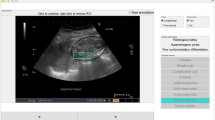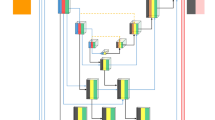Abstract
CKD is a medical condition that affects people all around the world and is a major health concern. It increases the risk of developing cardiovascular and cerebrovascular diseases, which can lead to serious illness and even death. Ultrasound imaging is typically the initial and most widely used diagnostic technique for individuals at risk for CKD. The existing methods are restricted by features with high dimensions, computational hurdles, and extended processing times. To address these issues, this article proposes the development of an enhanced deep-learning model with an optimum selection of features for the accurate diagnosis of CKD. The proposed technique begins with pre-processing, involving image filtering and contrast enhancement. Then, presented an improved Otsu’s algorithm for segmenting kidney masses, followed by a stage of feature extraction. A hybrid Lion Optimization Algorithm (LOA) and Moth flame Optimization (MFO) is a novel contributions to improve the convergence rate of the MFO algorithm. The hybrid FS algorithms select the optimal subset of features for disease classification. Finally, a novel Long-Term Recurrent Convolutional Network (LRCN) is introduced for detecting kidney impairment. The models are developed and validated utilizing a database of ultrasonography (US) images including four classes of Chronic kidney images: stone, cyst, tumor, and normal. The efficiency of the framework is assessed based on its of accuracy, precision, recall, F1-score, and specificity of 98.7%, 96.6%, 96.4%, 97.9%, and 96.2% respectively. In addition, testing results show that the framework obtains the best overall performance when compared to existing methods for the classification of ultrasound images.
















Similar content being viewed by others
Data availability
No data is generated during this Study.
References
Ahmad R, Mohanty BK (2021) Chronic kidney disease stage identification using texture analysis of ultrasound images. Biomed Signal Process Control 69:102695
Ahmed, TI, Bhola, J, Shabaz, M, Singla, J, Rakhra, M, More, S, Samori, IA (2022) Fuzzy logic-based systems for the diagnosis of chronic kidney disease. BioMed Res Int, 2022
Alex DM, Christinal AH, Chandy DA, Singh A, Pushkaran M (2020) Speckle noise suppression in 2D ultrasound kidney images using local pattern based topological derivative. Pattern Recogn Lett 131:49–55
Alkurdy NH, Aljobouri HK, Wadi ZK (2023) Ultrasound renal stone diagnosis based on convolutional neural network and vgg16 features. Int J Electr Comput Eng 13(3):3440–3448
Antony J, Ultrasound-images.com (2015) https://www.ultrasound-images.com/, Accessed: April, 2020
Aprilianto D (2020) SVM optimization with correlation feature selection based binary particle swarm optimization for diagnosis of chronic kidney disease. J Soft Comput Explor 1(1):24–31
Chaudhuri AK, Sinha D, Banerjee DK, Das A (2021) A novel enhanced decision tree model for detecting chronic kidney disease. Netw Model Anal Health Inf Bioinf 10:1–22
Chittora P, Chaurasia S, Chakrabarti P, Kumawat G, Chakrabarti T, Leonowicz Z, … Bolshev V (2021) Prediction of chronic kidney disease-a machine learning perspective. IEEE Access 9:17312–17334
Cui W, Li M, Gong G, Lu K, Sun S, Dong F (2020) Guided trilateral filter and its application to ultrasound image despeckling. Biomed Signal Process Control 55:101625
Eddy S, Mariani LH, Kretzler M (2020) Integrated multi-omics approaches to improve classification of chronic kidney disease. Nat Rev Nephrol 16(11):657–668
Elhoseny M, Shankar K, Uthayakumar J (2019) Intelligent diagnostic prediction and classification system for chronic kidney disease. Sci Rep 9(1):1–14
Geertsma T, Ultrasoundcases.info (2011) http://www.ultrasoundcases.info/, Accessed: April, 2020
Han X, Zhang S, Chen Z, Adhikari BK, Zhang Y, Zhang J, … Wang Y (2020) Cardiac biomarkers of heart failure in chronic kidney disease. Clin Chim Acta 510:298–310
Harimoorthy K, Thangavelu M (2021) Multi-disease prediction model using improved SVM-radial bias technique in healthcare monitoring system. J Ambient Intell Humaniz Comput 12(3):3715–3723
Hosseinzadeh M, Koohpayehzadeh J, Bali AO, Asghari P, Souri A, Mazaherinezhad A, … Rawassizadeh R (2021) A diagnostic prediction model for chronic kidney disease in internet of things platform. Multimed Tools Appl 80:16933–16950
Huang C, Li X, Wen Y (2021) AN OTSU image segmentation based on fruitfly optimization algorithm. Alexandria Eng J 60(1):183–188
Jain D, Singh V (2020) A novel hybrid approach for chronic disease classification. Int J Healthcare Inf Syst Inf (IJHISI) 15(1):1–19
Jerlin Rubini L, Perumal E (2020) Efficient classification of chronic kidney disease by using multi-kernel support vector machine and fruit fly optimization algorithm. Int J Imaging Syst Technol 30(3):660–673
Khamparia A, Saini G, Pandey B, Tiwari S, Gupta D, Khanna A (2020) KDSAE: chronic kidney disease classification with multimedia data learning using deep stacked autoencoder network. Multimed Tools Appl 79(47):35425–35440
Khare S, Kaushik P (2021) Speckle filtering of ultrasonic images using weighted nuclear norm minimization in wavelet domain. Biomed Signal Process Control 70:102997
Kim DH, Ye SY (2021) Classification of chronic kidney disease in sonography using the GLCM and artificial neural network. Diagnostics 11(5):864
Liao YT, Lee CH, Chen KS, Chen CP, Pai TW (2021) Data augmentation based on generative adversarial networks to improve stage classification of chronic kidney disease. Appl Sci 12(1):352
Ma F, Sun T, Liu L, Jing H (2020) Detection and diagnosis of chronic kidney disease using deep learning-based heterogeneous modified artificial neural network. Futur Gener Comput Syst 111:17–26
Mirjalili S (2015) Moth-flame optimization algorithm: a novel nature-inspired heuristic paradigm. Knowl-Based Syst 89:228–249
Navaneeth B, Suchetha M (2020) A dynamic pooling based convolutional neural network approach to detect chronic kidney disease. Biomed Signal Process Control 62:102068
Nithya A, Appathurai A, Venkatadri N, Ramji DR, Palagan CA (2020) Kidney disease detection and segmentation using artificial neural network and multi-kernel k-means clustering for ultrasound images. Measurement 149:106952
Pal, S (2022) Chronic kidney disease prediction using machine learning techniques. Biomed Mater Device, 1–7
Parthiban R, Usharani S, Saravanan D, Jayakumar D, Palani DU, StalinDavid DD, Raghuraman D (2021) Prognosis of chronic kidney disease (CKD) using hybrid filter wrapper embedded feature selection method. Eur J Mol Clin Med 7(9):2511–2530
Pradeepa, P, Jeyakumar, MK (2022) Modelling of IDBN with LSNN based optimal feature selection for the prediction of CKD using real time data. Multimed Tools Appl, 1–36
Puttagunta M, Ravi S (2021) Medical image analysis based on deep learning approach. Multimed Tools Appl 80:24365–24398
Qin J, Chen L, Liu Y, Liu C, Feng C, Chen B (2019) A machine learning methodology for diagnosing chronic kidney disease. IEEE Access 8:20991–21002
Rahimizadeh N, Hasanzadeh RP, Janabi-Sharifi F (2021) An optimized non-local LMMSE approach for speckle noise reduction of medical ultrasound images. Multimed Tools Appl 80:9231–9253
Raju P, Rao VM, Rao BP (2019) Optimal GLCM combined FCM segmentation algorithm for detection of kidney cysts and tumor. Multimed Tools Appl 78(13):18419–18441
Schena FP, Anelli VW, Abbrescia DI, Di Noia T (2022) Prediction of chronic kidney disease and its progression by artificial intelligence algorithms. J Nephrol 35(8):1953–1971
Senan EM, Al-Adhaileh MH, Alsaade FW, Aldhyani TH, Alqarni AA, Alsharif N, … Alzahrani MY (2021) Diagnosis of chronic kidney disease using effective classification algorithms and recurShobana, S., Rajaram, A., SteffenRaj, T., & MoonSon, A. L. (2022). Detection Of Kidney Stones Using Machine Learning. Tierarztliche Praxis, 42(4).ealthcare Eng 2021
Shobana S, Rajaram A, SteffenRaj T, MoonSon AL (2022) Detection Of kidney stones using machine learning. Tierarztliche Praxis, 42(4)
Singh V, Asari VK, Rajasekaran R (2022) A deep neural network for early detection and prediction of chronic kidney disease. Diagnostics 12(1):116
Sudharson S, Kokil P (2020) An ensemble of deep neural networks for kidney ultrasound image classification. Comput Methods Prog Biomed 197:105709
Sudharson S, Kokil P (2021) Computer-aided diagnosis system for the classification of multi-class kidney abnormalities in the noisy ultrasound images. Comput Methods Prog Biomed 205:106071
Viswanath K, Anilkumar B, Gunasundari R (2022) Design of deep learning reaction–diffusion level set segmentation approach for health care related to automatic kidney stone detection analysis. Multimed Tools Appl 81(29):41807–41849
WangNo, N, Chiewchanwattana, S, Sunat, K (2020) An efficient adaptive thresholding function optimized by a cuckoo search algorithm for a despeckling filter of medical ultrasound images. J Ambient Intell Humaniz Comput, 1–26
Wu Y, Yi Z (2020) Automated detection of kidney abnormalities using multi-feature fusion convolutional neural networks. Knowl-Based Syst 200:105873
Yazdani M, Jolai F (2016) Lion optimization algorithm (LOA): a nature-inspired metaheuristic algorithm. J Comput Des Eng 3(1):24–36
Zhang X, Yu Y, Gao Y, Chen X, Li W (2020) Research on singing voice detection based on a long-term recurrent convolutional network with vocal separation and temporal smoothing. Electronics 9:1458 [CrossRef]
Zheng Q, Furth SL, Tasian GE, Fan Y (2019) Computer-aided diagnosis of congenital abnormalities of the kidney and urinary tract in children based on ultrasound imaging data by integrating texture image features and deep transfer learning image features. J Pediatr Urol 15(1):75–e1
Funding
No funding for this Paper.
Author information
Authors and Affiliations
Corresponding author
Ethics declarations
Conflict of interest
On behalf of all authors, the corresponding author declares there is no conflict of Interest.
Additional information
Publisher’s note
Springer Nature remains neutral with regard to jurisdictional claims in published maps and institutional affiliations.
Rights and permissions
Springer Nature or its licensor (e.g. a society or other partner) holds exclusive rights to this article under a publishing agreement with the author(s) or other rightsholder(s); author self-archiving of the accepted manuscript version of this article is solely governed by the terms of such publishing agreement and applicable law.
About this article
Cite this article
Mactina, F.J.N., Neduncheliyan, S. Multi-classification of kidney abnormalities in sonography using the LOA-MFO and long-term recurrent convolutional network. Multimed Tools Appl 83, 13577–13612 (2024). https://doi.org/10.1007/s11042-023-16013-5
Received:
Revised:
Accepted:
Published:
Issue Date:
DOI: https://doi.org/10.1007/s11042-023-16013-5




